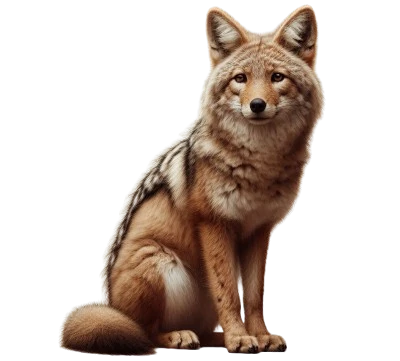
The Golden Jackal (Canis aureus) is a medium-sized canid known for its opportunistic nature and adaptability. It inhabits a wide geographical range, from the Middle East to the Balkans, and plays an important role in its ecosystem.
The Golden Jackal is a medium-sized canid, typically measuring between 50 and 60 cm at the shoulder and weighing between 8 and 15 kg. It has a dense coat that is usually golden in color, often marked with brown and gray hues. Its slim, elongated body and narrow head are well adapted for hunting and moving through varied environments. The jackal also has large, erect ears and a relatively long snout, features typical of its family.
The Golden Jackal (Canis aureus) belongs to the Canidae family.
The Golden Jackal is a distinct species from the Gray Wolf, although they share many characteristics due to their common genus. The jackal is smaller in size and tends to have more solitary behavior, although some populations form groups.
The Golden Jackal is highly adaptable, inhabiting a wide range of environments including savannas, forests, mountains, and semi-arid regions. Its range stretches across much of South Asia, the Balkans, and North Africa, although it has also been observed in more isolated areas. It is often found in open territories, but can also take refuge in wooded or mountainous regions when seeking to avoid danger.
The Golden Jackal is primarily solitary but can form small families or temporary groups, especially when hunting or defending territory. It is opportunistic, and its diet varies depending on the availability of resources. It can hunt alone or in groups and is known for its efficiency in capturing small mammals, birds, and reptiles. It uses a wide range of vocalizations to communicate with its pack members or to mark its territory.
The Golden Jackal is an opportunistic carnivore, primarily feeding on small mammals, birds, insects, and fruits. It will also scavenge from carcasses when available. This flexible diet allows it to survive in environments where prey may be scarce. Its dietary flexibility is one of the factors contributing to its success as a predator.
The Golden Jackal is not currently endangered, although some populations are threatened by habitat loss, human conflict, and competition with other predators such as wild dogs or wolves. Conservation efforts are focused on protecting its natural habitats and reducing human-wildlife conflicts. Due to its adaptability, it is less vulnerable than some other canids.
The Golden Jackal belongs to the genus Canis, which also includes the Gray Wolf (Canis lupus), the Coyote (Canis latrans), and the Black-Backed Jackal (Canis mesomelas). These species share common characteristics, such as their social structure and varied diet.
Observing the Golden Jackal in the wild can be a rewarding experience, but it is important to follow certain guidelines to avoid disturbing its natural behavior.
By following these tips, you will help preserve the integrity of the Golden Jackal's habitat while enjoying a respectful observation.